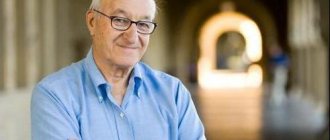Basic foreign theories of personality
In foreign psychology there are a huge number of different theories of personality. Conventionally, all of them can be divided into three large groups: psychoanalytic, behavioral and humanistic theories.
1. Psychoanalytic concept of S. Freud. One of the most widespread theories that still influences personality psychology is Freudianism. This theory arose during that period of personality research, which we defined as clinical. The creator of this theory is S. Freud. Subsequently, on the basis of Freudianism, a whole series of theories arose that can be conditionally united into the group of theories of neo-Freudianism.
Considering the problem of behavior, Freud identifies two needs that determine human mental activity: libidinal and aggressive. But since the satisfaction of these needs encounters obstacles from the outside world, they are repressed, forming the region of the unconscious. But still, sometimes they break through, bypassing the “censorship” of consciousness, and appear in the form of symbols. The main sections of Freud's personality theory were problems of the unconscious, the structure of the mental apparatus, personality dynamics, development, neuroses, methods of studying personality. Subsequently, many famous psychologists (K. Horney, G. Sullivan, E. Fromm, A. Freud, M. Klein, E. Erikson, F. Alexander, etc.) developed, deepened and expanded precisely these aspects of his theory.
2. K. Jung’s personality typology. He distinguishes two types of personality: extroverts (oriented towards the outside world) and introverts (oriented towards the world of their own experiences). K. Jung was one of the first students of Freud to dissociate himself from his teacher. The main reason for the disagreement between them was Freud's idea of pansexualism. But Jung fought against Freud not from a materialistic, but from an idealistic position. Jung called his system “analytical psychology.” According to Jung, the human psyche includes three levels: consciousness, the personal unconscious and the collective unconscious. The decisive role in the structure of a person’s personality is played by the collective unconscious, formed from traces of memory left by the entire past of humanity.
3. A. Adler’s theory of inferiority complex. Another, no less famous student of Freud, who left his teacher, was A. Adler, the founder of the so-called individual psychology. He sharply opposed Freud's biologizing theory. Adler emphasized that the main thing in a person is not his natural instincts, but a social feeling, which he called the “sense of community.” This feeling is innate, but it must be socially developed. He opposed Freud's view that man is from birth aggressive, that his development is determined by biological needs.
In his opinion, the personality structure is uniform, and the determinant in personality development is a person’s desire for superiority. However, this desire cannot always be realized. Thus, due to a defect in the development of bodily organs, a person begins to experience a feeling of inferiority; it can also arise in childhood due to unfavorable social conditions. A person strives to find ways to overcome feelings of inferiority and resorts to various types of compensation. Adler examines different forms of compensation (adequate, inadequate) and talks about its possible levels
4. Personality Theory by K. Horney. The listed authors did not consider themselves direct followers of Freud. The main representatives of neo-Freudianism are the direct students of Z. Freud - K. Horney and G. S. Sullivan. Karen Horney was at first a devoted student of Freud. In 1939, already in the USA, she published the book “The Neurotic Personality of Our Time,” in which she warmly thanks her teacher. However, she soon began to sharply criticize Freud for his attempt to reduce the mechanisms of human behavior to two tendencies - libidinal and aggressive, as well as for pansexualism.
5. Concept (theory) of personality by K. Rogers. He called his method of therapy non-directive, i.e. focused on the patient. According to this method, the doctor should not put pressure on the patient. Contact between doctor and patient should be based on respect for each other; Moreover, both of them are full participants in the conversation or contact. The function of the therapist is to create a situation where the doctor acts as the second “I” of the client and treats his inner world with understanding. Deep respect for the individual position of the individual is the only rule of therapy. The client in such a situation feels that all his internal experiences and sensations are perceived with interest and approval, this helps to discover new aspects of his experience, sometimes for the first time to realize the meaning of certain of his experiences.
6. Personality theory by A. Maslow. According to him, the basic human need is self-actualization, the desire for self-improvement and self-expression. To the main question of his theory - What is self-actualization? – Maslow answers: “Self-actualizing people are all, without exception, involved in some kind of work... They are devoted to this work, it is something very valuable to them - it is a kind of calling.” All people of this type strive for the realization of higher values, which, as a rule, cannot be reduced to something even higher. These values (among them - goodness, truth, decency, beauty, justice, perfection, etc.) act as vital needs for them. Existence for a self-actualizing personality appears as a process of constant choice, as a constant solution to Hamlet’s problem “to be or not to be.” At every moment of life, an individual has a choice: moving forward, overcoming obstacles that inevitably arise on the path to a high goal, or retreat, giving up the fight and giving up positions.
7. Janet's theory of personality. Speaking about various personality theories, we cannot fail to say a few words about the French psychological school and its most outstanding representative, P. Jean. Janet expressed the opinion that various mental processes are phenomena that prepare actions. Feelings and thinking are processes that regulate actions. The basis for the development of personality is the doctrine of behavior. But Janet does not use the concept of behavior in the behaviorist sense. It is considered as including not only the externally observable activity of the individual, but also the internal mental content, which becomes an integral part of behavior, its regulating link.
Janet's position that the structure of mental processes includes the process of regulation is extremely important. Essentially, here the idea is already anticipated, which found its further development in the works of Russian psychologists L. S. Vygotsky, S. L. Rubinstein, A. N. Leontiev, L. I. Bozhovich and others, namely, the transformation of an individual into a person is determined by the fact that there is an opportunity for regulation and self-regulation. Janet says that the human psyche develops in cooperation with other people. First, a person cooperates with others and only then, on the basis of this, can he regulate his own behavior. The structure of the behavioral act proposed by Janet seems interesting. In accordance with it, three stages are distinguished in a behavioral act: internal preparation for action, execution of action and completion of action. As we see, this description of the behavioral act already includes an idea of the purpose of the action.
8. D. Watson's concept of personality. All human behavior can be described schematically using the terms “stimulus” (S) and “response” (R). Watson believed that a person is initially endowed with some simple reactions and reflexes, but the number of these hereditary reactions is small. Almost all human behavior is the result of learning through conditioning. The formation of skills, according to Watson, begins at the earliest stages of life. The systems of basic skills or habits are as follows:
1) visceral, or emotional;
2) manual;
3) laryngeal, or verbal.
Watson defined personality as a derivative of systems of habits. Personality can be described as the sum of actions that can be detected through the practical study of behavior over a sufficiently long period of time. Personality problems and mental health disorders for behaviorists are not problems of consciousness, but behavioral disorders and habit conflicts that should be “treated” through conditioning and deconditioning. All subsequent studies following Watson's work were aimed at studying the stimulus-response relationship. Another famous American scientist B.F. Skinner tried to go beyond this formula to take into account the effects of the environment on the body after the reaction has occurred. He created the theory of operant conditioning.
Afterword
The concepts discussed are similar in some ways, but completely different in others. In particular, there is no clear answer about what ultimately comes first: man or society, nature or the environment.
But if we focus on domestic concepts, we can note that a person becomes a person under the influence of society, through relationships and the assimilation of cultural experience.
You can read more about what personality is in the articles “The concept of personality in psychology: essence and structure” and “Personality orientation - what is it in psychology.”
—>
In foreign psychology there are a huge number of different theories of personality. Conventionally, all of them can be divided into three large groups: psychoanalytic, behavioral and humanistic theories.
1. Psychoanalytic concept of S. Freud. One of the most widespread theories that still influences personality psychology is Freudianism. This theory arose during that period of personality research, which we defined as clinical. The creator of this theory is S. Freud. Subsequently, on the basis of Freudianism, a whole series of theories arose that can be conditionally united into the group of theories of neo-Freudianism.
Considering the problem of behavior, Freud identifies two needs that determine human mental activity: libidinal and aggressive. But since the satisfaction of these needs encounters obstacles from the outside world, they are repressed, forming the region of the unconscious. But still, sometimes they break through, bypassing the “censorship” of consciousness, and appear in the form of symbols. The main sections of Freud's personality theory were problems of the unconscious, the structure of the mental apparatus, personality dynamics, development, neuroses, methods of studying personality. Subsequently, many famous psychologists (K. Horney, G. Sullivan, E. Fromm, A. Freud, M. Klein, E. Erikson, F. Alexander, etc.) developed, deepened and expanded precisely these aspects of his theory.
2. K. Jung’s personality typology. He distinguishes two types of personality: extroverts (oriented towards the outside world) and introverts (oriented towards the world of their own experiences). K. Jung was one of the first students of Freud to dissociate himself from his teacher. The main reason for the disagreement between them was Freud's idea of pansexualism. But Jung fought against Freud not from a materialistic, but from an idealistic position. Jung called his system “analytical psychology.” According to Jung, the human psyche includes three levels: consciousness, the personal unconscious and the collective unconscious. The decisive role in the structure of a person’s personality is played by the collective unconscious, formed from traces of memory left by the entire past of humanity.
3. A. Adler’s theory of inferiority complex. Another, no less famous student of Freud, who left his teacher, was A. Adler, the founder of the so-called individual psychology. He sharply opposed Freud's biologizing theory. Adler emphasized that the main thing in a person is not his natural instincts, but a social feeling, which he called the “sense of community.” This feeling is innate, but it must be socially developed. He opposed Freud's view that man is from birth aggressive, that his development is determined by biological needs.
In his opinion, the personality structure is uniform, and the determinant in personality development is a person’s desire for superiority. However, this desire cannot always be realized. Thus, due to a defect in the development of bodily organs, a person begins to experience a feeling of inferiority; it can also arise in childhood due to unfavorable social conditions. A person strives to find ways to overcome feelings of inferiority and resorts to various types of compensation. Adler examines different forms of compensation (adequate, inadequate) and talks about its possible levels
4. Personality Theory by K. Horney. The listed authors did not consider themselves direct followers of Freud. The main representatives of neo-Freudianism are the direct students of Z. Freud - K. Horney and G. S. Sullivan. Karen Horney was at first a devoted student of Freud. In 1939, already in the USA, she published the book “The Neurotic Personality of Our Time,” in which she warmly thanks her teacher. However, she soon began to sharply criticize Freud for his attempt to reduce the mechanisms of human behavior to two tendencies - libidinal and aggressive, as well as for pansexualism.
5. Concept (theory) of personality by K. Rogers. He called his method of therapy non-directive, i.e. focused on the patient. According to this method, the doctor should not put pressure on the patient. Contact between doctor and patient should be based on respect for each other; Moreover, both of them are full participants in the conversation or contact. The function of the therapist is to create a situation where the doctor acts as the second “I” of the client and treats his inner world with understanding. Deep respect for the individual position of the individual is the only rule of therapy. The client in such a situation feels that all his internal experiences and sensations are perceived with interest and approval, this helps to discover new aspects of his experience, sometimes for the first time to realize the meaning of certain of his experiences.
6. Personality theory by A. Maslow. According to him, the basic human need is self-actualization, the desire for self-improvement and self-expression. To the main question of his theory - What is self-actualization? – Maslow answers: “Self-actualizing people are all, without exception, involved in some kind of work... They are devoted to this work, it is something very valuable to them - it is a kind of calling.” All people of this type strive for the realization of higher values, which, as a rule, cannot be reduced to something even higher. These values (among them - goodness, truth, decency, beauty, justice, perfection, etc.) act as vital needs for them. Existence for a self-actualizing personality appears as a process of constant choice, as a constant solution to Hamlet’s problem “to be or not to be.” At every moment of life, an individual has a choice: moving forward, overcoming obstacles that inevitably arise on the path to a high goal, or retreat, giving up the fight and giving up positions.
7. Janet's theory of personality. Speaking about various personality theories, we cannot fail to say a few words about the French psychological school and its most outstanding representative, P. Jean. Janet expressed the opinion that various mental processes are phenomena that prepare actions. Feelings and thinking are processes that regulate actions. The basis for the development of personality is the doctrine of behavior. But Janet does not use the concept of behavior in the behaviorist sense. It is considered as including not only the externally observable activity of the individual, but also the internal mental content, which becomes an integral part of behavior, its regulating link.
Janet's position that the structure of mental processes includes the process of regulation is extremely important. Essentially, here the idea is already anticipated, which found its further development in the works of Russian psychologists L. S. Vygotsky, S. L. Rubinstein, A. N. Leontiev, L. I. Bozhovich and others, namely, the transformation of an individual into a person is determined by the fact that there is an opportunity for regulation and self-regulation. Janet says that the human psyche develops in cooperation with other people. First, a person cooperates with others and only then, on the basis of this, can he regulate his own behavior. The structure of the behavioral act proposed by Janet seems interesting. In accordance with it, three stages are distinguished in a behavioral act: internal preparation for action, execution of action and completion of action. As we see, this description of the behavioral act already includes an idea of the purpose of the action.
8. D. Watson's concept of personality. All human behavior can be described schematically using the terms “stimulus” (S) and “response” (R). Watson believed that a person is initially endowed with some simple reactions and reflexes, but the number of these hereditary reactions is small. Almost all human behavior is the result of learning through conditioning. The formation of skills, according to Watson, begins at the earliest stages of life. The systems of basic skills or habits are as follows:
1) visceral, or emotional;
2) manual;
3) laryngeal, or verbal.
Watson defined personality as a derivative of systems of habits. Personality can be described as the sum of actions that can be detected through the practical study of behavior over a sufficiently long period of time. Personality problems and mental health disorders for behaviorists are not problems of consciousness, but behavioral disorders and habit conflicts that should be “treated” through conditioning and deconditioning. All subsequent studies following Watson's work were aimed at studying the stimulus-response relationship. Another famous American scientist B.F. Skinner tried to go beyond this formula to take into account the effects of the environment on the body after the reaction has occurred. He created the theory of operant conditioning.
Sources used:
- https://psychologist.tips/733-teorii-lichnosti-otechestvennye-i-zarubezhnye.html
- https://studopedia.ru/2_57316_osnovnie-zarubezhnie-teorii-lichnosti.html










